Unconformities and Gold in New Zealand: Potential Analogues for the Archean Witwatersrand of South Africa
Abstract
1. Introduction
2. Approach and Methods
2.1. Witwatersrand Supergroup Background
2.2. Southern New Zealand as a Witwatersrand Analogue
- The New Zealand crust hosts sedimentary basins (Figure 3) of similar scale (up to 7 km thick) to the Witwatersrand basin;
- The New Zealand sedimentary basins have many diverse unconformities within the sedimentary sequence, allowing comparison to the unconformities that are a key part of the Central Rand Group architecture (Figure 2b);
- Southern New Zealand has widespread primary and placer gold (Figure 3), so that the nature of placer gold deposits in young and active compressional basins can be readily observed;
- Phanerozoic examples are resolvable because of the contrasting marine and non-marine fossils in the various associated sediments.
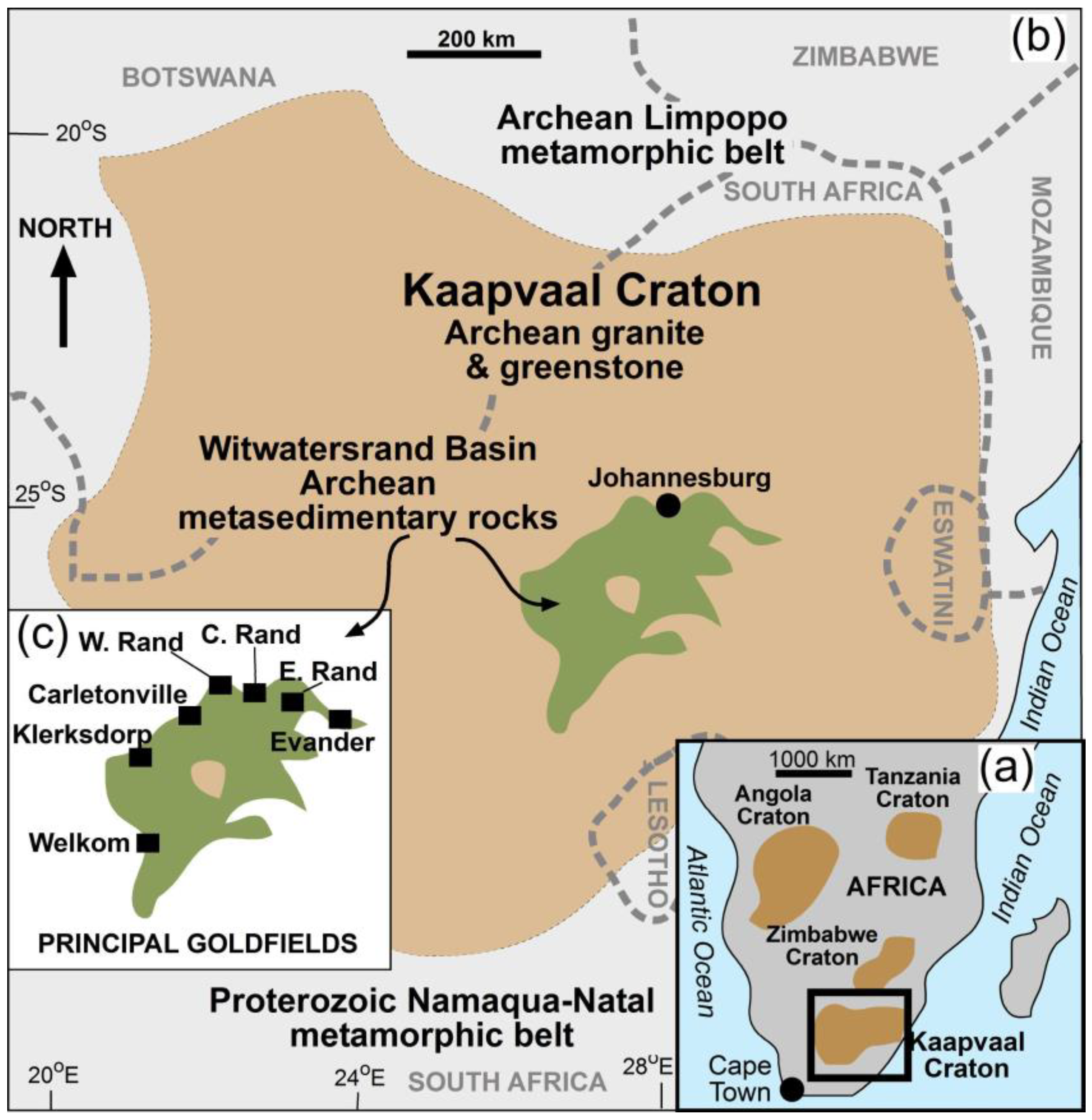
2.3. Fluvial Channel Terminology
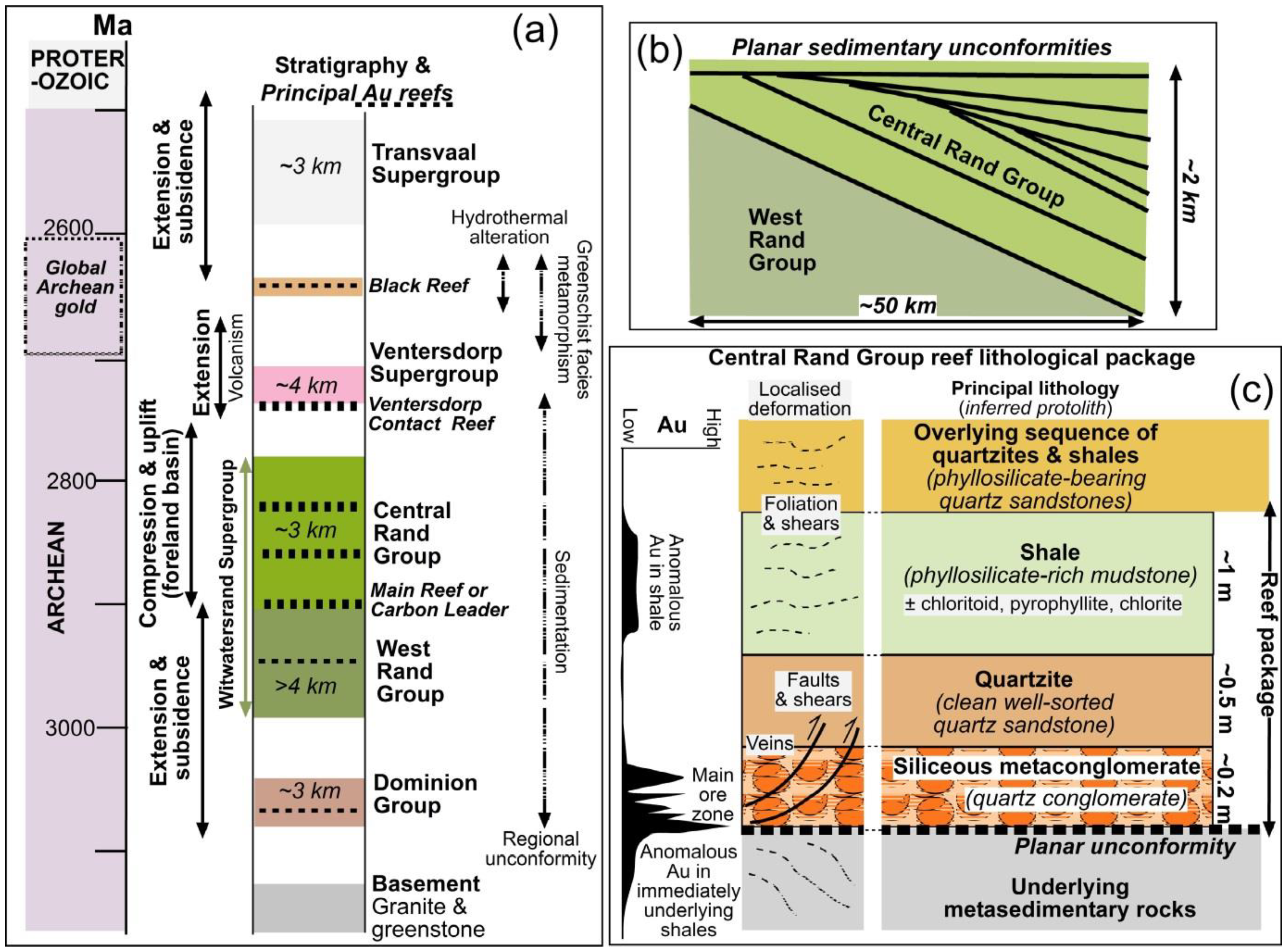

3. Observations on Archean Witwatersrand, South Africa
3.1. Witwatersrand Structure and Stratigraphy
3.2. Unconformities in the Witwatersrand Supergroup
3.3. Gold and the Witwatersrand Unconformities
- Welkom (Basal Reef);
- Klerksdorp (Vaal Reef, Ventersdorp Contact Reef, VCR);
- Carletonville (Main Reef group, e.g. Carbon Leader, VCR);
- West Rand (Main Reef group, Bird Reefs, Kimberley Reef, VCR);
- Central Rand (Main Reef group, Kimberley Reef);
- East Rand (Main Reef group, Kimberley Reef);
- Evander (Kimberley Reef).
4. Cretaceous–Holocene Geology of South Island, New Zealand
4.1. Geological Setting
4.2. Planar Marine Unconformities
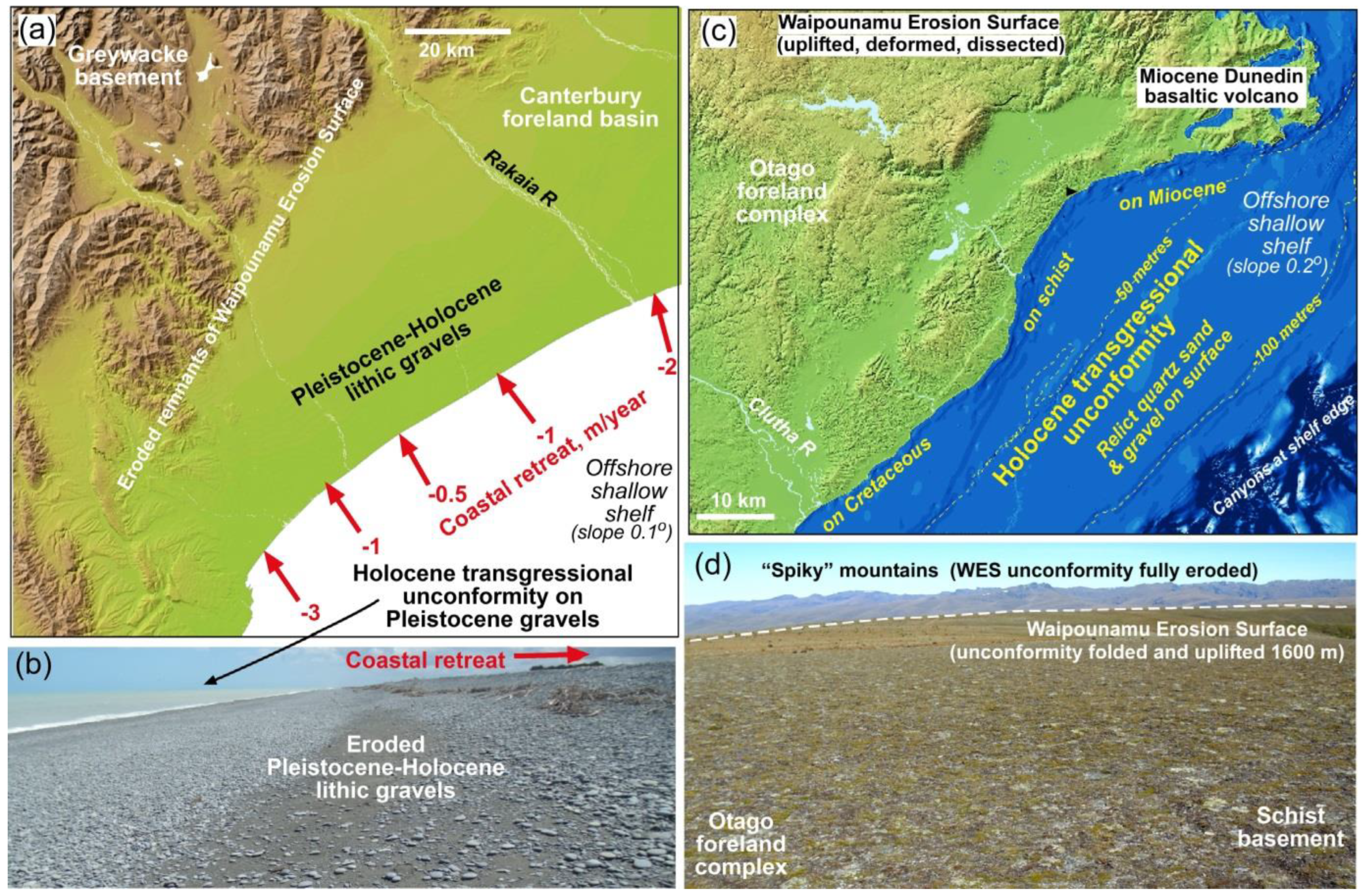

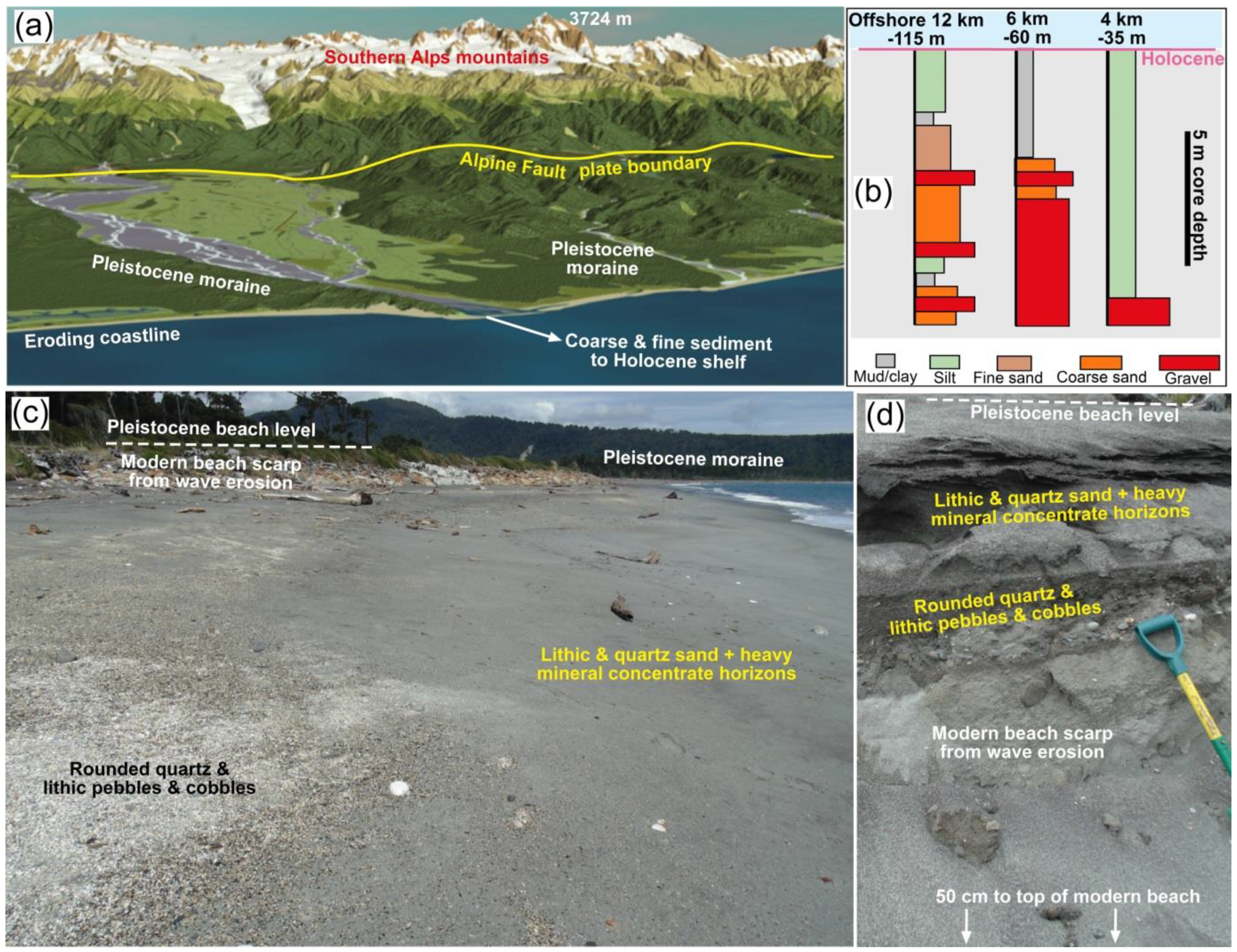
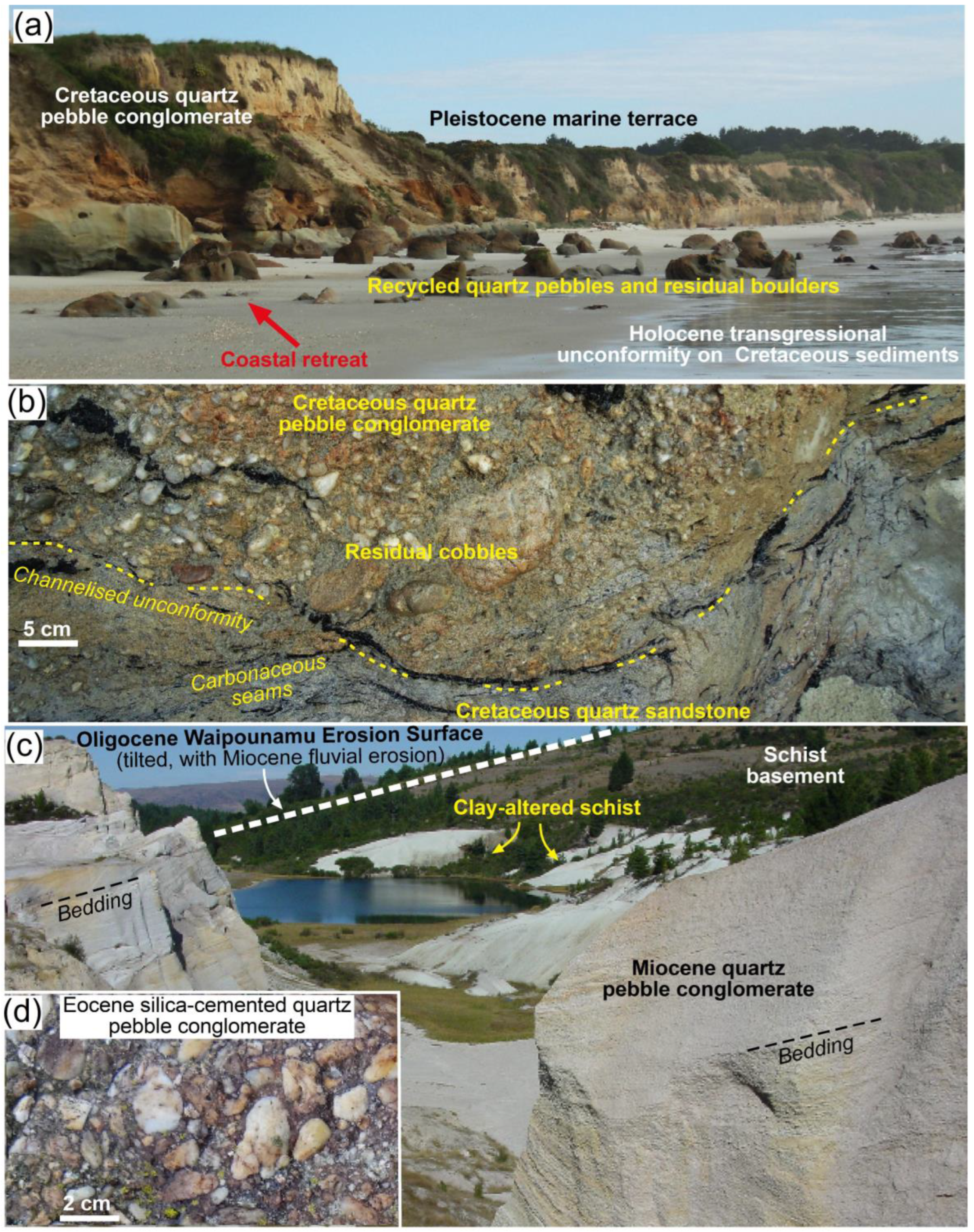
4.3. Non-Marine Unconformities
4.4. Placer Gold Concentrations in New Zealand
4.5. Mineral Transformations in Young Sediments
5. Discussion
5.1. Marine Transgression Unconformity Surfaces Globally
5.2. Gold Placers on Marine Unconformities
5.3. Fluvial Processes and Placer Gold
5.4. The Schematic Channels Interpreted in Witwatersrand Gold Mines
5.5. Post-Depositional Changes
5.6. Critical Comparison: New Zealand Placers with Witwatersrand Gold
6. Summary and Conclusions
Author Contributions
Funding
Data Availability Statement
Acknowledgments
Conflicts of Interest
References
- Pretorius, D.A. Gold and uranium in quartz-pebble conglomerates. Econ. Geol. 1981, 75, 117–138. [Google Scholar]
- Phillips, G.N.; Law, J.D.M. Witwatersrand goldfields: Geology, genesis and exploration. SEG Rev. 2000, 13, 439–500. [Google Scholar]
- McCarthy, T.S. The Witwatersrand Supergroup. In The Geology of South Africa; Johnson, M.R., Anhaeusser, C.R., Thomas, R.J., Eds.; Geological Society of South Africa: Johannesburg, South Africa; Council of Geoscience: Pretoria, South Africa, 2006; pp. 155–186. [Google Scholar]
- Winter, H.D.L.R.; Brink, M.C. Chronostratigraphic subdivision of the Witwatersrand Basin based on Western Transvaal composite columns. S. Afr. J. Geol. 1991, 94, 191–203. [Google Scholar]
- Jolley, S.J.; Henderson, I.H.C.; Barnicoat, A.C.; Fox, N.P.C. Thrust-Fracture Network and Hydrothermal Gold Mineralization: Witwatersrand Basin, South Africa. In Fluid Flow and Mineralization; Special Publications; Mccaffrey, K.J.W., Lonergan, L., Wilkinson, J.J., Eds.; Geological Society: London, UK, 1999; Volume 155, pp. 153–165. [Google Scholar]
- Phillips, G.N. Metamorphism of the Witwatersrand goldfields: Conditions during peak metamorphism. J. Metamorph. Geol. 1987, 5, 307–322. [Google Scholar] [CrossRef]
- Bekker, G.F. The Witwatersrand Banket, with Notes on Other Gold-Bearing Pudding Stones; US Government Survey 18th Annual Report; US Government: Washington, DC, USA, 1897; Part V; pp. 153–184.
- Minter, W.E.L. Irrefutable detrital origin of Witwatersrand gold and evidence of eolian signatures. Econ. Geol. 1999, 94, 665–670. [Google Scholar] [CrossRef]
- Craw, D.; Youngson, J.H.; Leckie, D.A. Transport and concentration of detrital gold in foreland basins. Ore Geol. Rev. 2006, 28, 417–430. [Google Scholar] [CrossRef]
- Graton, L.C. Hydrothermal origin of the Rand gold deposits: Testimony of the conglomerates. Econ. Geol. 1930, 25, 1–185. [Google Scholar] [CrossRef]
- Verrezen, L. The facies technique of using sedimentology in valuation: A case study on the Vaal Reef palaeoplacer. Geocongress 1986, 86, 487–490. [Google Scholar]
- Bailey, A.C.; Law, J.D.M.; Cadle, A.B.; Phillips, G.N. The Zandfontein Quartzite Formation, a marine deposit in the Central Rand Group, Witwatersrand Supergroup. S. Afr. J. Geol. 1990, 93, 135–146. [Google Scholar]
- Brock, B.B.; Pretorius, D.A. Rand Basin Sedimentation and Tectonics. In The Geology of Some Ore Deposits in Southern Africa; Haughton, S.H., Ed.; Geological Society South Africa: Johannesburg, South Africa, 1964; pp. 549–599. [Google Scholar]
- Minter, W.E.L. Detrital gold, uranium, and pyrite concentrations related to sedimentology in the Precambrian Vaal Reef placer, Witwatersrand, South Africa. Econ. Geol. 1976, 71, 157–176. [Google Scholar] [CrossRef]
- Frimmel, H.E.; Minter, W.E.L. Recent developments concerning the geological history and genesis of the Witwatersrand gold deposits. S. Afr. Soc. Econ. Geol. Spec. Publ. 2002, 9, 17–45. [Google Scholar]
- Catuneanu, O. Flexural partitioning of the Late Archaean Witwatersrand foreland system, South Africa. Sed. Geol. 2001, 141, 95–112. [Google Scholar] [CrossRef]
- Turnbull, I.M.; Allibone, A.H. Geology of the Murihiku Area. In 1:250,000 Geological Map 20; Institute of Geological & Nuclear Sciences: Lower Hutt, NZ, USA, 2003. [Google Scholar]
- Cox, S.C.; Barrell, D.J.A. Geology of the Aoraki Area. In 1:250,000 Geological Map 15; Institute of Geological & Nuclear Sciences: Lower Hutt, NZ, USA, 2007. [Google Scholar]
- Craw, D.; Youngson, J.H.; Koons, P.O. Gold dispersal and placer formation in an active oblique collisional mountain belt, Southern Alps, New Zealand. Econ. Geol. 1999, 94, 605–614. [Google Scholar] [CrossRef]
- Youngson, J.H.; Craw, D.; Falconer, D.M. Evolution of Cretaceous–Cenozoic quartz-pebble conglomerate gold placers during basin formation and inversion, southern New Zealand. Ore Geol. Rev. 2006, 28, 451–474. [Google Scholar] [CrossRef]
- Upton, P.; Craw, D. Coeval emplacement and orogen-parallel transport of gold in oblique convergent orogens. Tectonophysics 2016, 693, 197–209. [Google Scholar] [CrossRef]
- Roy, S.; Upton, P.; Craw, D. Gold in the hills: Patterns of placer gold accumulation under dynamic tectonic and climatic conditions. Miner. Depos. 2018, 53, 981–995. [Google Scholar] [CrossRef]
- Williams, G.J. Economic Geology of New Zealand. Australas. Inst. Min. Met. Monogr. 1974, 4, 490. [Google Scholar]
- Falconer, D.M.; Craw, D. Supergene gold mobility: A textural and geochemical study from gold placers in southern New Zealand. In: Supergene environments, processes and products. Econ. Geol. Spec. Publ. 2009, 14, 77–93. [Google Scholar]
- Craw, D. River drainage reorientation during placer gold accumulation, southern New Zealand. Miner. Depos. 2013, 48, 841–860. [Google Scholar] [CrossRef]
- Craw, D.; Mitchell, M.; McCann, R.; Reay, A. Compositional variations and morphological evolution in platinum beach placers, southern New Zealand. Miner. Depos. 2013, 48, 81–97. [Google Scholar] [CrossRef]
- Craw, D.; Kerr, G.; Reith, F.; Falconer, D. Pleistocene paleodrainage and placer gold redistribution, western Southland, New Zealand. N. Z. J. Geol. Geophys. 2015, 58, 137–153. [Google Scholar] [CrossRef]
- Craw, D.; Kerr, G.; Falconer, D. Mineralogy and provenance of auriferous Waimumu Quartz Gravels, Southland, New Zealand. N. Z. J. Geol. Geophys. 2015, 58, 281–295. [Google Scholar] [CrossRef]
- Craw, D.; Hesson, M.; Kerr, G. Morphological evolution of gold nuggets in proximal sedimentary environments, southern New Zealand. Ore Geol. Rev. 2016, 80, 784–799. [Google Scholar] [CrossRef]
- Craw, D.; Kerr, G. Physical and chemical evolution of a Pleistocene marginal marine gold paleoplacer deposit, southern New Zealand. Ore Geol. Rev. 2021, 138, 104341. [Google Scholar] [CrossRef]
- Kerr, G.; Malloch, K.; Lilly, K.; Craw, D. Diagenetic alteration of a Mesozoic fluvial gold placer deposit, southern New Zealand. Ore Geol. Rev. 2017, 83, 14–29. [Google Scholar] [CrossRef]
- Fraser, N. Technical Report for Offshore Sampling of PP51979, West Coast; NZ Petroleum and Minerals, Mineral Report Series MR4761; Seafield Resources Ltd.: Toronto, ON, Canada, 2011; p. 89. [Google Scholar]
- Phillips, G.N.; Powell, R. Hydrothermal alteration in the Witwatersrand goldfields. Ore Geol. Rev. 2015, 65, 245–273. [Google Scholar] [CrossRef]
- Minter, W.E.L.; Hill, W.C.N.; Kidger, R.J.; Kingsley, R.J.; Snowden, P.A. The Welkom Gold Field. In Mineral Deposits of Southern Africa; Anhaeusser, C.R., Maske, S., Eds.; Geological Society of South Africa: Johannesburg, South Africa, 1986; Volume 1, pp. 497–539. [Google Scholar]
- Phillips, G.N. Anomalous gold in Witwatersrand shales. Econ. Geol. 1987, 82, 2179–2186. [Google Scholar] [CrossRef]
- Vearncombe, J.R.; McNaughton, N.J.; Porter, J.; Zi, J.-W.; Talavera, C. Age of the Archaean Murchison belt and mineralisation, South Africa. S. Afr. J. Geol. 2021, 124, 315–342. [Google Scholar] [CrossRef]
- Groves, D.I.; Goldfarb, R.J.; Robert, F.; Hart, C.J.R. Gold deposits in metamorphic belts: Overview of current understanding, outstanding problems, future research, and exploration significance. Econ. Geol. 2003, 98, 1–29. [Google Scholar]
- Armstrong, R.A.; Compston, W.; Retief, E.A.; Williams, I.S.; Welke, H.J. Zircon ion microprobe studies bearing on the age and evolution of the Witwatersrand triad. Precambrian Res. 1991, 53, 243–266. [Google Scholar] [CrossRef]
- Kositcin, N.; Krapĕz, B. Relationship between detrital zircon age-spectra and the tectonic evolution of the Late Archaean Witwatersrand Basin, South Africa. Precambrian Res. 2004, 129, 141–168. [Google Scholar] [CrossRef]
- Kositcin, N.; McNaughton, N.J.; Griffin, B.J.; Fletcher, I.R.; Groves, D.I.; Rasmussen, B. Textural and geochemical discrimination between zenotime of different origin in the Archaean Witwatersrand Basin, South Africa. Geochim. Cosmochim. Acta 2003, 67, 709–731. [Google Scholar] [CrossRef]
- Gaucher, C.; Frei, R. The Archean-Proterozoic Boundary and Great Oxidation Event. In Chemostratigraphy Across Major Chronological Boundaries; Sial, A.N., Gaucher, C., Ramkumar, M., Ferreira, V.P., Eds.; American Geophys Union Monograph; American Geophysical Union: Washington, DC, USA, 2018; Volume 240, pp. 35–46. [Google Scholar]
- Smith, A.J.B.; Beukes, N.J.; Gutzmer, J. The composition and depositional environments of Mesoarchean iron formations of theWest Rand Group of theWitwatersrand Supergroup, South Africa. Econ. Geol. 2013, 108, 111–134. [Google Scholar] [CrossRef]
- Burke, K.; Kidd, W.S.; Kusky, T.M. Archean foreland basin tectonics in the Witwatersrand Basin, South Africa. Tectonics 1986, 5, 439–456. [Google Scholar] [CrossRef]
- Catuneanu, O. Retroarc foreland systems—evolution through time. J. Afr. Earth Sci. 2004, 38, 225–242. [Google Scholar] [CrossRef]
- Barnicoat, A.C.; Henderson, I.H.C.; Knipe, R.J.; Yardley, B.W.D.; Napier, R.W.; Fox, N.P.C.; Kenyon, A.K.; Muntingh, D.J.; Strydom, D.; Winkler, K.S.; et al. Hydrothermal gold mineralization in the Witwatersrand Basin. Nature 1997, 386, 820–824. [Google Scholar] [CrossRef]
- Coward, M.P.; Spencer, R.M.; Spencer, C.E. Development of the Witwatersrand Basin, South Africa. In Early Precambrian Processes; Special Publications; Coward, M.P., Ries, A.C., Eds.; Geological Society: London, UK, 1995; Volume 95, pp. 243–269. [Google Scholar]
- Jolley, S.J.; Freeman, S.R.; Barnicoat, A.C.; Phillips, G.M.; Knipe, R.J.; Pather, A.; Fox, N.P.C.; Strydom, D.; Birch, M.T.G.; Henderson, I.H.C.; et al. Structural controls on Witwatersrand gold mineralisation. J. Struct. Geol. 2004, 26, 1067–1086. [Google Scholar] [CrossRef]
- Pretorius, D.A. The Geology of the Central Rand Goldfield. In The Geology of Some Ore Deposits of Southern Africa; Haughton, S.H., Ed.; Geological Society South Africa: Johannesburg, South Africa, 1964; Volume 1, pp. 63–108. [Google Scholar]
- Frimmel, H.E.; Groves, D.I.; Kirk, J.; Ruiz, J.; Chesley, J.; Minter, W.E.L. The formation and preservation of the Witwatersrand goldfields, the World’s largest gold province. Econ. Geol. 2005, 100, 769–797. [Google Scholar]
- Frimmel, H.E.; Nwaila, G.T. Geologic evidence of syngenetic gold in the Witwatersrand Goldfields, South Africa. Econ. Geol. Spec. Publ. 2020, 23, 645–668. [Google Scholar]
- Phillips, G.N.; Myers, R.E.; Palmer, J.A. Problems with the placer model for Witwatersrand gold. Geology 1987, 15, 1027–1030. [Google Scholar] [CrossRef]
- Phillips, G.N.; Myers, R.E. The Witwatersrand goldfields. II: An origin for Witwatersrand gold during metamorphism and associated alteration. Econ. Geol. Monogr. 1989, 6, 598–608. [Google Scholar]
- Barnicoat, A.C.; Phillips, G.M.; Law, J.D.M.; Walshe, J.L.; Phillips, G.N.; Fox, N.P.C. Refuting the Irrefutable: A New Look at a Well-Known Sample of Witwatersrand Gold Mineralisation. In Proceedings of the 2001: A Hydrothermal Odyssey Extended Abstracts, Townsville, Australia, 17–19 May 2001; Volume 59, pp. 16–17. [Google Scholar]
- Phillips, G.N.; Myers, R.E.; Law, J.D.M.; Bailey, A.C.; Cadle, A.B.; Beneke, S.D.; Giusti, L. The Witwatersrand goldfields. I: Post-depositional history, syn-sedimentary processes, and gold distribution. Econ. Geol. Monogr. 1989, 6, 585–597. [Google Scholar]
- Wiebols, J.H. Note on chloritoid in the Witwatersrand System. Trans. Geol. Soc. S. Afr. 1961, 64, 85–98. [Google Scholar]
- Austin, M.A. Topographic Control of Facies in the Proterozoic Carbon Leader Placer. In Proceedings of the Geocongress ’86; Extended Abstracts: An International Earth Science Congress, Johannesburg, South Africa, 7–11 July 1986; Geological Society of South Africa: Johannesburg, South Africa, 1986; pp. 437–440. [Google Scholar]
- Parnell, J. Petrographic evidence for emplacement of carbon into Witwatersrand conglomerates under high fluid pressure. Sed. Res. 1999, 69, 164–170. [Google Scholar] [CrossRef]
- Palmer, J.A.; Phillips, G.N.; McCarthy, T.S. Paleosols and their relevance to Precambrian atmospheric composition. J. Geol. 1989, 97, 77–92. [Google Scholar] [CrossRef] [PubMed]
- Phillips, G.N. Widespread fluid infiltration during metamorphism of the Witwatersrand goldfields: Generation of chloritoid and pyrophyllite. J. Metam. Geol. 1988, 6, 311–332. [Google Scholar] [CrossRef]
- Berlenbach, J.W. Aspects of bedding-parallel faulting associated with the Ventersdorp Contact Reef on the Kloof gold mine. S. Afr. J. Geol. 1995, 98, 335–348. [Google Scholar]
- Jolley, S.J.; Stuart, G.W.; Freeman, S.R.; Knipe, R.J.; Kershaw, D.; Mcallister, E.; Barnicoat, A.C.; Tucker, R.F. Progressive evolution of a late orogenic thrust system, from duplex development to extensional reactivation and disruption: Witwatersrand Basin, South Africa. In Deformation of the Continental Crust: The Legacy of Mike Coward; Special Publications; Geological Society: London, UK, 2007; Volume 272, pp. 543–569. [Google Scholar]
- Greenberg, R. Structure-gold relationships as revealed by some Witwatersrand mine survey plans. Trans. Inst. Min. Metall. 1964, 73, 1–10. [Google Scholar]
- Pitts, P.A. Aspects of Shear Strain in the East Rand Basin. In Natural Sciences; Rand Afrikaans University: Johannesburg, South Africa, 1990; p. 145. [Google Scholar]
- Mullins, M. Economic Gold Mineralisation in Shear Zones. In Rand Leases Gold Mine: Other Reefs Symposium; Extended Abstracts; Geological Society of South Africa: Johannesburg, South Africa, 1989; pp. 85–86. [Google Scholar]
- Roering, C.; Smit, C.A. Bedding parallel shear thrusting and quartz vein formation in Witwatersrand quartzite. J. Struct. Geol. 1987, 9, 419–427. [Google Scholar] [CrossRef]
- Coetzee, D.S.; Van Reenen, D.D.; Roering, C. Quartz vein formation, metamorphism, and fluid inclusions associated with thrusting and bedding-parallel shear in Witwatersrand quartzites, South Africa. S. Afr. J. Geol. 1995, 98, 371–381. [Google Scholar]
- Els, B.G. The question of alluvial fans in the auriferous Archaean and Proterozoic successions of South Africa. S. Afr. J. Geol. 1998, 101, 17–26. [Google Scholar]
- Landis, C.A.; Campbell, H.J.; Begg, J.G.; Mildenhall, D.C.; Paterson, A.M.; Trewick, S.A. The Waipounamu erosion surface: Questioning the antiquity of the New Zealand land surface and terrestrial fauna and flora. Geol. Mag. 2008, 145, 173–197. [Google Scholar] [CrossRef]
- Carter, R.M.; Carter, L.; Williams, J.J.; Landis, C.A. Moderm and Relict Sedimentation on the South Otago Continental Shelf, New Zealand. In New Zealand Oceanographic Institute Memoir; New Zealand Oceanographic Institute Memoir: Wellington, New Zealand, 1985; Volume 93, p. 43. [Google Scholar]
- Carter, L.; Carter, R.M. Holocene evolution of the nearshore sand wedge, South Otago continental shelf, New Zealand. N. Z. J. Geol. Geophys. 1986, 29, 413–424. [Google Scholar] [CrossRef]
- Leckie, D.A. Canterbury Plains, New Zealand: Implications for sequence stratigraphic models. AAPG Bull. 1994, 78, 1240–1256. [Google Scholar]
- Mortensen, J.K.; Craw, D.; MacKenzie, D.J.; Gabites, J.E.; Ullrich, T. Age and origin of orogenic gold mineralisation in the Otago Schist belt, South Island, New Zealand: Constraints from lead isotope and 40Ar/39Ar dating studies. Econ. Geol. 2010, 105, 777–793. [Google Scholar] [CrossRef]
- Craw, D.; MacKenzie, D. Macraes Gold Deposit, New Zealand. In Springer Briefs in World Mineral Deposits; Springer: Cham, Switzerland, 2016; p. 130. ISBN 978-3-319-35158-2. [Google Scholar]
- Ritchie, T.; Scott, J.; Craw, D. Garnet compositions track longshore migration of beach placers in western New Zealand. Econ. Geol. 2019, 114, 513–540. [Google Scholar] [CrossRef]
- Chamberlain, C.P.; Poage, M.A.; Craw, D.; Reynolds, R.C. Topographic development of the Southern Alps recorded by the isotopic composition of authigenic clay minerals, South Island, New Zealand. Chem. Geol. 1999, 155, 279–294. [Google Scholar] [CrossRef]
- Butt, C.R.M. Genesis of supergene gold deposits in the lateritic regolith of the Yilgarn Block, Western Australia. Econ. Geol. Monogr. 1989, 6, 460–470. [Google Scholar]
- Anand, R.R.; Paine, M. Regolith geology of the Yilgarn craton. Aust. J. Earth Sci. 2002, 49, 3–162. [Google Scholar] [CrossRef]
- Craw, D. Placer gold and associated supergene mineralogy at Macraes Flat, East Otago, New Zealand. N. Z. J. Geol. Geophys. 2017, 60, 353–367. [Google Scholar] [CrossRef]
- Youngson, J.H.; Craw, D. Variation in placer style, morphology and gold particle behaviour down gravel-bed rivers: An example from the Shotover/Arrow-Kawarau-Clutha River system, Otago, New Zealand. Econ. Geol. 1999, 94, 615–634. [Google Scholar] [CrossRef]
- James, N.P.; Bone, Y.; Carter, R.M.; Murray-Wallace, C.V. Origin of the late Neogene Roe Plains and their calcarenite veneer: Implications for sedimentology and tectonics in the Great Australian Bight. Aust. J. Earth Sci. 2006, 53, 407–419. [Google Scholar] [CrossRef]
- Gregory, J.W. The Origin of the Gold in the Rand Banket. Trans. Geol. Soc. S. Afr. Annex. 1908, 17, 2–41. [Google Scholar]
- Young, R.B. The Banket: A Study of the Auriferous Conglomerates of the Witwatersrand and the Associated Rocks; Gurney and Jackson: London, UK, 1917; p. 125. [Google Scholar]
- Sharpe, J.M. The economic auriferous banket of Upper Witwatersrand Beds and their relationship to sedimentation features. Geol. Soc. S. Afr. Trans. 1949, 52, 265–300. [Google Scholar]
- Brink, M.C. Tektoniese en Stratigrafiese Ontwikkeling van Die Witwatersrand-Supergroep en Verwante Gesteentes in Die Gebied Noord en oos van Klerksdorp. Ph.D Thesis, Randse Afrikaanse University, Johannesburg, South Africa, 1986; p. 330. [Google Scholar]
- Verrezen, L. Sedimentology of the Vaal Reef Palaeoplacer in the Western Portion of Vaal Reef Gold Mine. Master’s Thesis, Randse Afrikaanse Universiteit, Johannesburg, South Africa, 1987. [Google Scholar]
- Cadle, A.; Bailey, A.; Law, J.; Phillips, G.N. How valid is the fluvial model for the Witwatersrand Basin? Soc. Econ. Paleontol. Mineral. 1987, 4, 11. [Google Scholar]
- Christie, A.B. Exploration of Placer Titanomagnetite Iron Sand Deposits Offshore from the West Coast of the North Island. In Mineral Deposits of New Zealand: Exploration and Research; Christie, A.B., Ed.; Australasian Institute of Mining and Metallurgy: Carlton, Australia, 2016; Volume 31, pp. 443–450. [Google Scholar]
- Sainsbury, C.L. Geology, ore deposits and mineral potential of the Seward Peninsula, Alaska. US Bur. Mines Open File Rep. 1975, 73, 108. [Google Scholar]
- Coetzee, C.B. Mineral Resources of the Republic of South Africa Handbook 7; Geological Survey South Africa: Johannesburg, South Africa, 1976; pp. 17–30. [Google Scholar]
- Pretorius, D.A. The depositional environment of the Witwatersrand gold fields: A chronologic review of speculations and observations. Miner. Sci. Eng. 1975, 7, 18–47. [Google Scholar]
- Boyle, R.W. The geochemistry of gold and its deposits. Geol. Surv. Can. Bull. 1979, 280, 579. [Google Scholar]
- Hughes, M.J.; Phillips, G.N.; Carey, S.P. Giant placers of the Victorian gold province. SEG Newsl. 2004, 56, 11–18. [Google Scholar] [CrossRef]
- Garnett, R.H.T.; Bassett, N.C. Placer deposits. Econ. Geol. 2005, 100, 813–843. [Google Scholar]
- Minter, W.E.L. A sedimentological synthesis of placer gold, uranium and pyrite concentrations in Proterozoic Witwatersrand sediments. In Fluvial Sedimentology; Miall, A.D., Ed.; Canadian Society of Petroleum Geologists: Calgary, AB, Canada, 1978; Volume 5, pp. 801–829. [Google Scholar]
- Phillips, G.N.; Zhou, T.; Powell, R. Metamorphic temperature variations among Witwatersrand goldfields: Evidence from the pyrophyllite—chloritoid—chlorite mineral assemblage. S. Afr. J. Geol. 1997, 100, 393–404. [Google Scholar]
- Nenna, F.; Aydin, A. The formation and growth of pressure solution seams in clastic rocks: A field and analytical study. J. Struct. Geol. 2011, 33, 633–643. [Google Scholar] [CrossRef]
- Haile, B.G.; Line, L.H.; Klausen, T.G.; Olaussen, S.; Eide, C.H.; Jahren, J.; Hellevang, H. Quartz overgrowth textures and fluid inclusion thermometry evidence for basin-scale sedimentary recycling: An example from the Mesozoic Barents Sea Basin. Basin Res. 2020, 33, 1697–1710. [Google Scholar] [CrossRef]
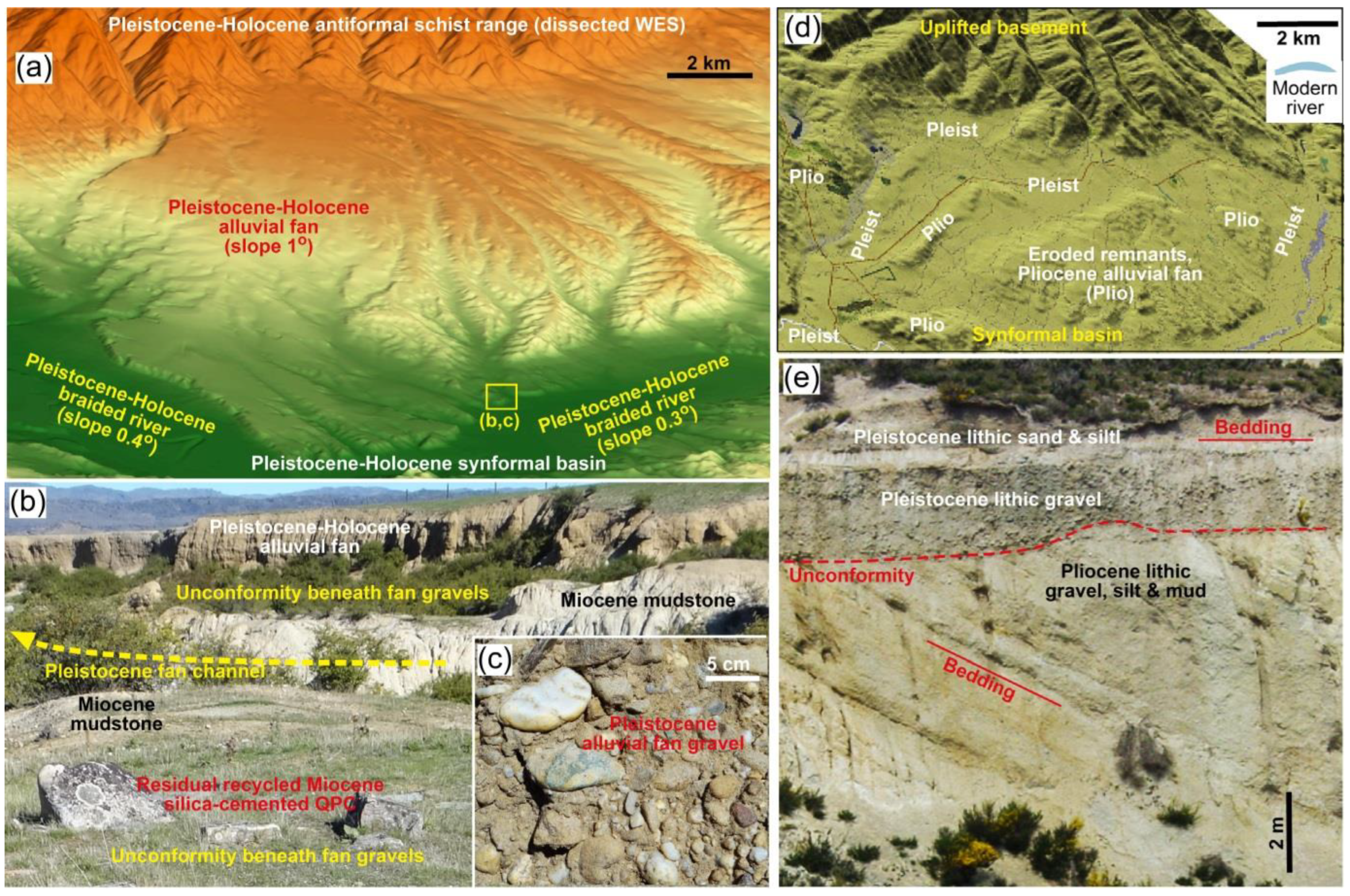

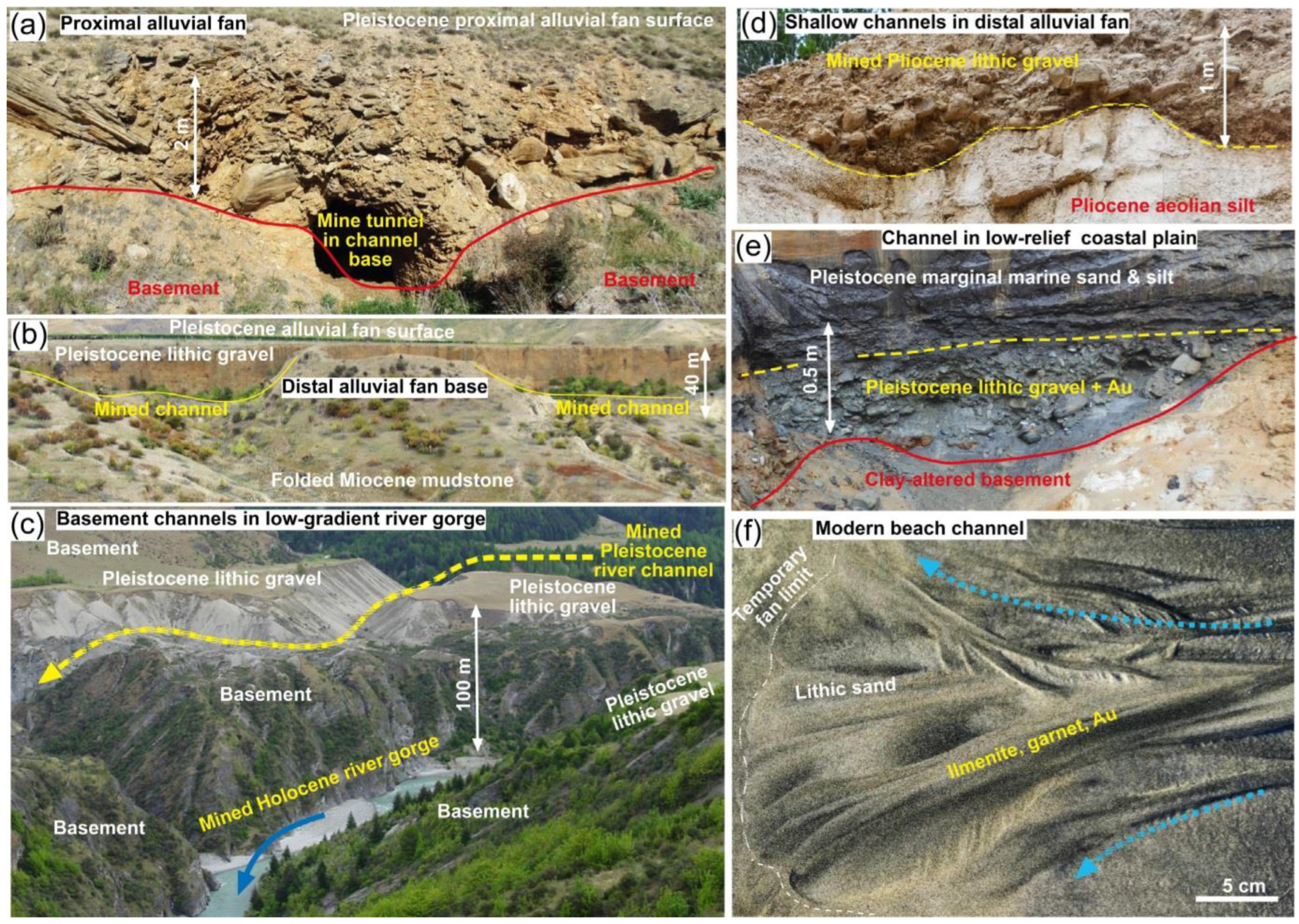
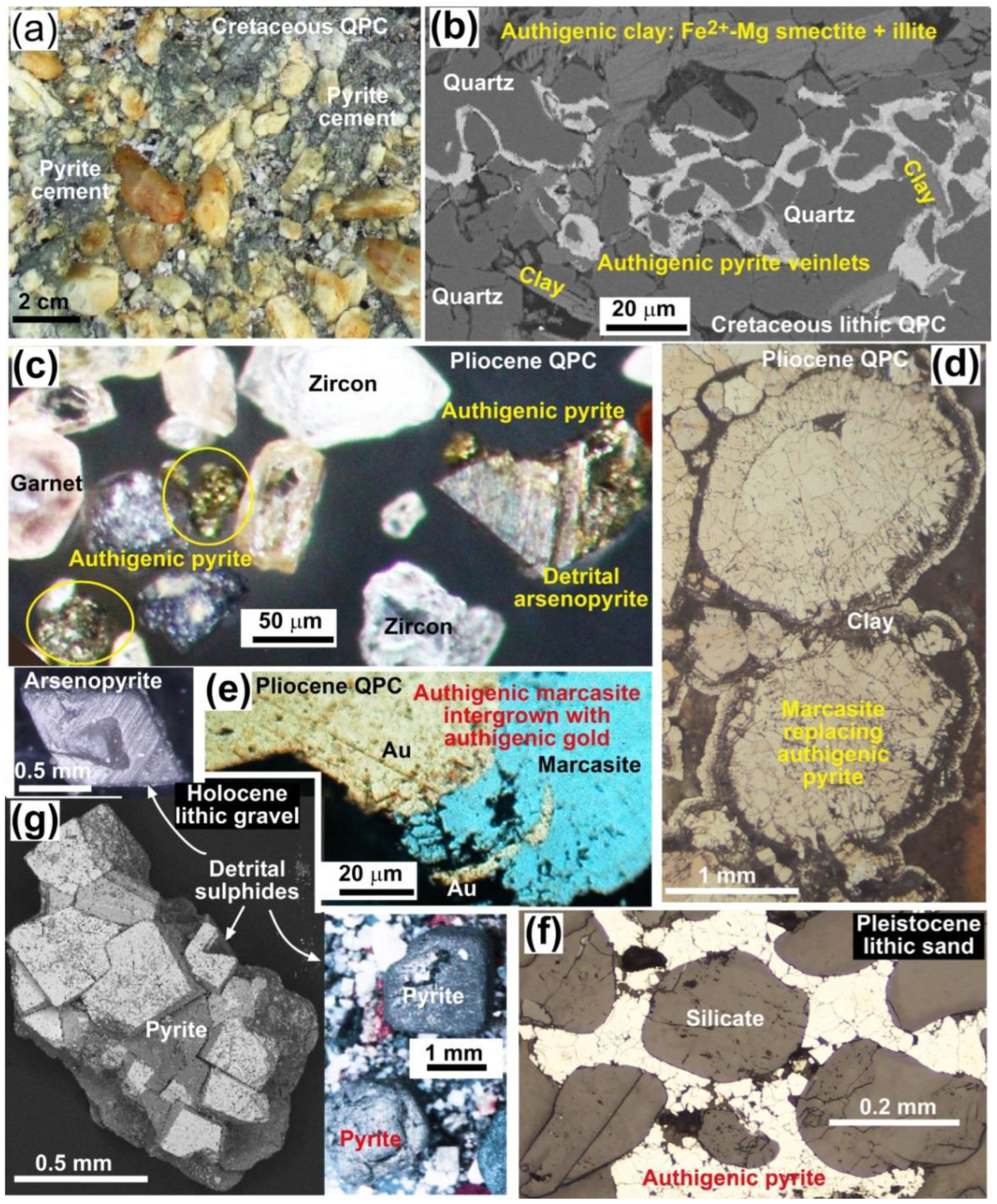
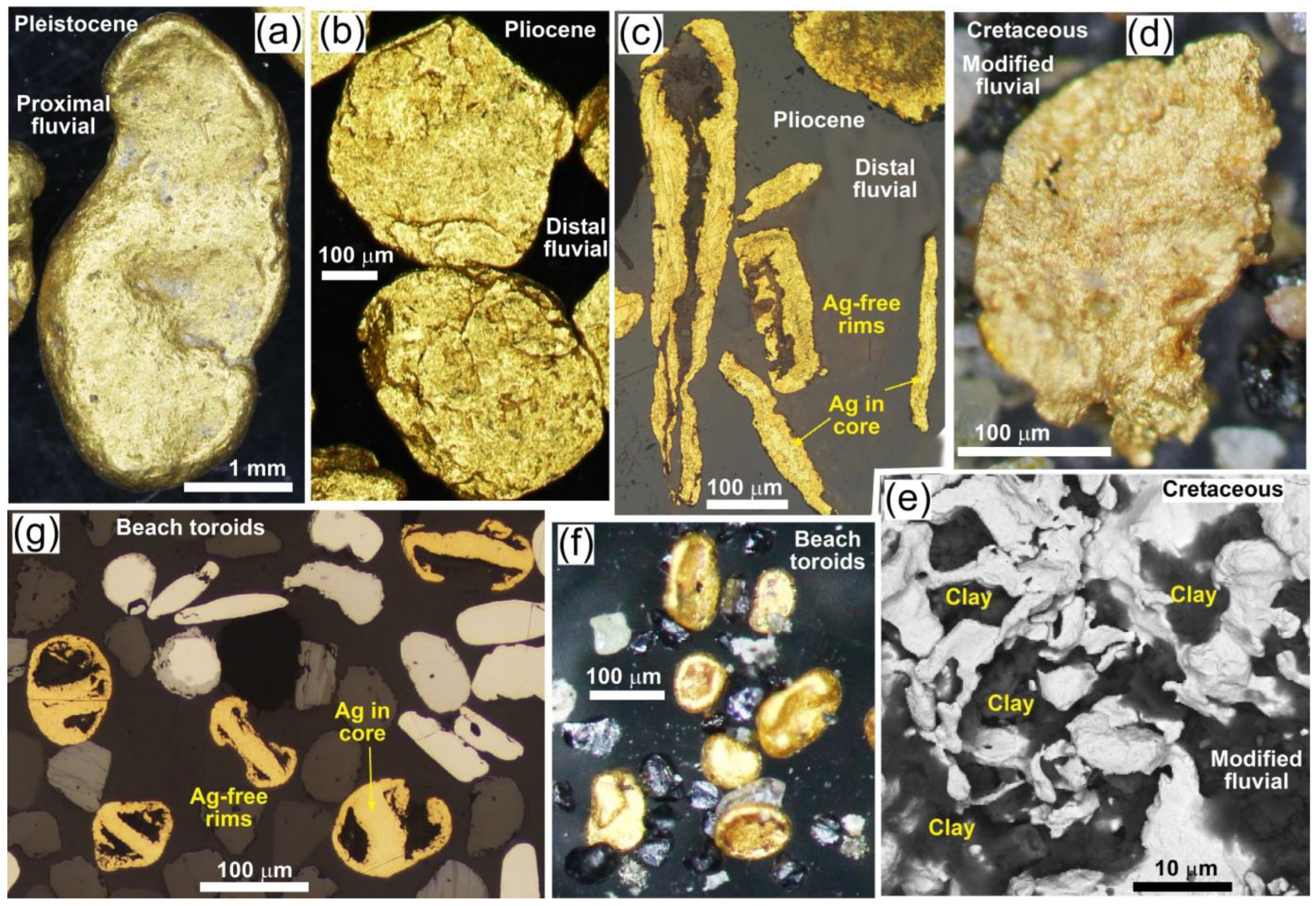
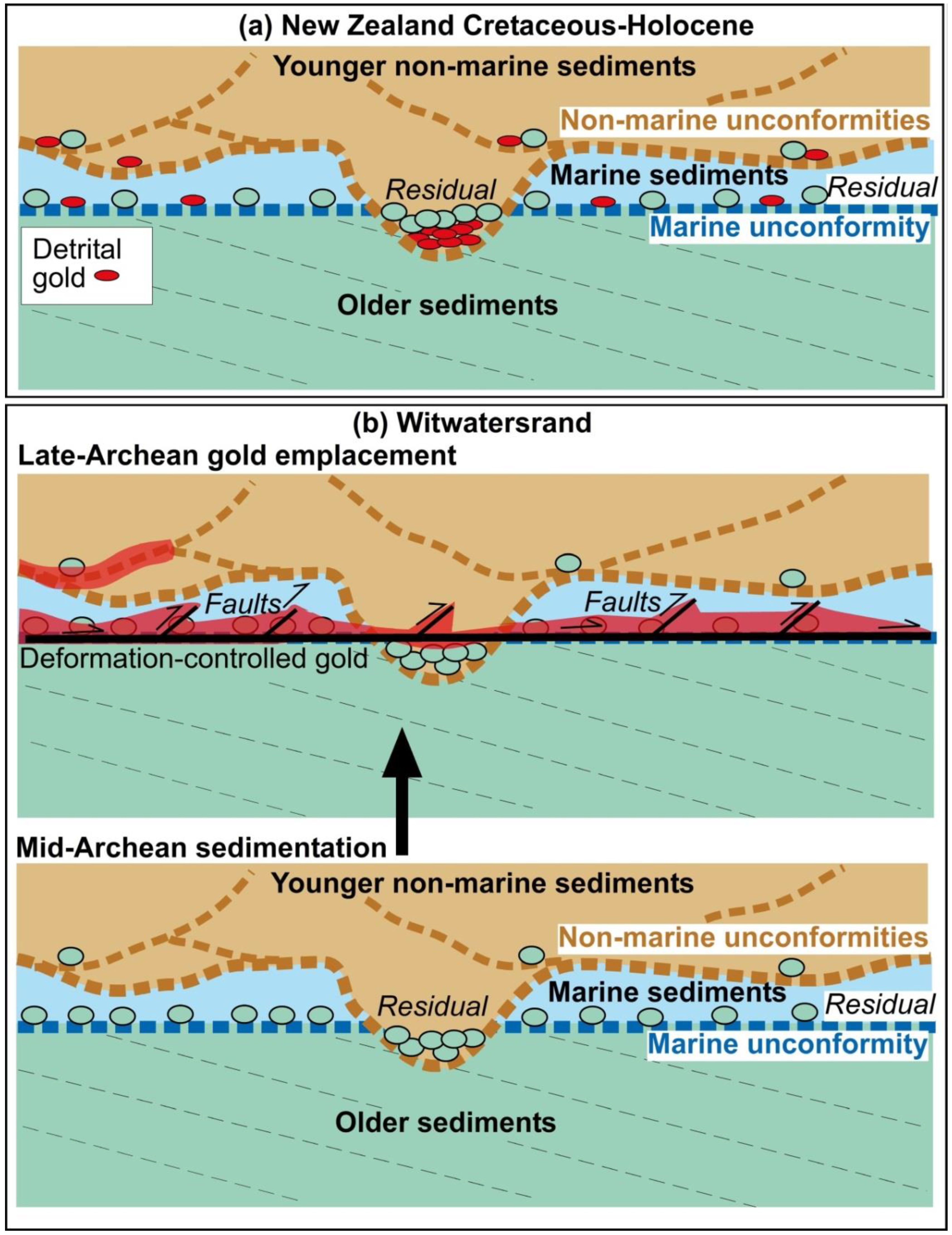
| Basin | Otago | Waiau | Canterbury | Westland |
|---|---|---|---|---|
| Style | Foreland complex | Oblique foreland | Foreland | Inboard wedge |
| Tectonics | Compression | Transpression | Compression | Transpression |
| Age of foreland sediments | Miocene–Holocene | Miocene–Holocene | Miocene–Holocene | Miocene–Holocene |
| Crustal thickness | ~25 km | ~25 km | <20 km | >30 km |
| Basement rocks | Schist | Greywacke, crystalline | Greywacke | Schist, crystalline |
| Basement exposure | At and above sea level | Below sea level | Below sea level | At and below sea level |
| Precursor Cretaceous–Oligocene extensional sediments | Coastal, up to 1 km thick; eroded from inland | Locally >3 km thick | Locally >2 km thick | Mostly eroded; minor remnants |
| Placer ages | Cretaceous–Holocene | Miocene–Holocene | Modern | Pleistocene–Holocene |
| Fluvial placers | Abundant; 8 Moz production | Minor production | Negligible; dilution dominates | Common, post-glacial; 7 Moz production |
| Fluvial placer unconformity control | Basement; syn-sedimentary deformation and erosion | Local basement ribs | Local basement ribs | Local basement exposures; syn-sedimentary deformation and erosion |
| Beach placers | Rare, negligible production | Abundant; minor production | Negligible production | Common; moderate production |
| Gold source | Otago; Mesozoic veins in schist | Otago: Miocene veins ± Mesozoic veins | Southern Alps; Plio-Pleistocene veins | Southern Alps; Plio-Pleistocene veins |
| Placer recycling | Frequent, Cretaceous– Holocene uplift and erosion created QPCs | Common; Pleistocene uplift and erosion | No data | Common; Pleistocene sea-level changes |
| Age gap, source-to-placer | Wide; 50–110 Ma | Coeval to ~20 Ma | Coeval to ~5 Ma | Coeval to ~5 Ma |
| Placer hosts | Lithic conglomerates; Cretaceous–Pleistocene QPC | Lithic conglomerates and sands | Lithic conglomerates and sands | Lithic conglomerates and sands |
| Principal associated heavy minerals | Magnetite, hematite, garnet, zircon | Ilmenite, garnet, zircon, platinum | Zircon, epidote | Ilmenite, garnet, zircon |
| Gold particle sizes | 2 to 0.1 mm flakes; rare cm nuggets | 1 mm flakes to 0.1 mm toroids and spheroids | <0.5 mm flakes, incipient toroids | 2 to 0.1 mm flakes; rare nuggets |
| Gold transport direction, Miocene–Holocene | Various; rivers from uplifted ranges across basin complex | SW orogen-parallel rivers; SE longshore drift | SE orogen-oblique rivers | NW orogen-normal rivers; NE longshore drift |
| Clay alteration in placers | Widespread in basement and sediments, Cretaceous–Pliocene | Localised in Pleistocene sediments and basement | Nil | Nil |
| Silica cementation associated with placers | Common in QPCs; recycled siliceous cobbles in Cretaceous–Holocene sediments | Nil | Nil | Nil |
| Authigenic pyrite in placers | Common, Cretaceous– Pliocene; minor detrital sulphides | Localised; Miocene– Pleistocene | Nil | Nil |
Disclaimer/Publisher’s Note: The statements, opinions and data contained in all publications are solely those of the individual author(s) and contributor(s) and not of MDPI and/or the editor(s). MDPI and/or the editor(s) disclaim responsibility for any injury to people or property resulting from any ideas, methods, instructions or products referred to in the content. |
© 2023 by the authors. Licensee MDPI, Basel, Switzerland. This article is an open access article distributed under the terms and conditions of the Creative Commons Attribution (CC BY) license (https://creativecommons.org/licenses/by/4.0/).
Share and Cite
Craw, D.; Phillips, N.; Vearncombe, J. Unconformities and Gold in New Zealand: Potential Analogues for the Archean Witwatersrand of South Africa. Minerals 2023, 13, 1041. https://doi.org/10.3390/min13081041
Craw D, Phillips N, Vearncombe J. Unconformities and Gold in New Zealand: Potential Analogues for the Archean Witwatersrand of South Africa. Minerals. 2023; 13(8):1041. https://doi.org/10.3390/min13081041
Chicago/Turabian StyleCraw, Dave, Neil Phillips, and Julian Vearncombe. 2023. "Unconformities and Gold in New Zealand: Potential Analogues for the Archean Witwatersrand of South Africa" Minerals 13, no. 8: 1041. https://doi.org/10.3390/min13081041
APA StyleCraw, D., Phillips, N., & Vearncombe, J. (2023). Unconformities and Gold in New Zealand: Potential Analogues for the Archean Witwatersrand of South Africa. Minerals, 13(8), 1041. https://doi.org/10.3390/min13081041





